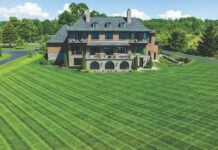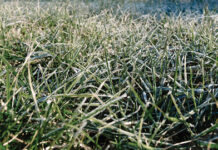Different turf management programs have different approaches to water use. During most years in New England, less rainfall in the summer coupled with heat and high evaporative demand activate a natural tendency of turfgrass plants: dormancy. Dormancy can save management resources during high summer, and when approached properly turf areas typically recover satisfactorily when conditions moderate in late summer or early fall.
Since turf aesthetics and several functional aspects suffer when turf enters dormancy, summer irrigation to supplement natural rainfall is usually necessary in systems for which performance is a high priority (golf courses, sports fields, high-value ornamental lawns, etc). On the other side of the coin, irrigation is of little concern or perhaps not even possible in some lower maintenance systems (roadside turf, for example). Regardless of management level, there is growing motivation in recent years to reduce water use for turf maintenance to the lowest possible level. In some cases, water restrictions force the issue by physically limiting the amount of water available for irrigation, or rising costs impose actionable pressure on budgets.
Sometimes, however, Mother Nature steps in with a twist of her own. We have not even reached summer yet, and suddenly find ourselves in a difficult spot in terms of water this spring. While we were flush with moisture going into last winter and immediately following snow melt, things have quickly dried out and many parts of the state and region have had little in the way of measurable precipitation in over three weeks. The situation has been further exacerbated by hot weather in recent days coupled with seemingly constant breezy conditions.
The timing is really not great, as this period of the spring is critical for winter recovery, root development, and a number of key management activities. Regardless of the normal approach to water use in any given system, the following are reminders about the important role of water in some common spring practices. While in many years natural precipitation helps a great deal to support these activities with a little planning, intervention in the form of supplemental irrigation may be needed this spring to meet management goals.
Fertilizers – Water is necessary for release of nutrients from fertilizer materials, to support microbial breakdown for materials that require it, and for nutrient availability, mobility and plant absorption. Lack of moisture in conjunction with applications could result in problems such as insufficient turf response, uneven response, and undesirable carryover of material beyond the target period.
Preemergence herbicides – The vast majority of preemergence herbicides require watering-in in order to “activate” the material, especially granular and on-fertilizer formulations. If water from irrigation or natural rainfall is not supplied in an amount specified on the product label, and within a reasonable time following application, reduced control or failure could result.
Grub control – As with preemergence herbicides, preventive grub control products whether chemical, biological or otherwise, also require watering-in to realize any chance of success. The grubs live below the surface of the soil, and a sufficient amount of water is necessary to carry the materials through the thatch and into the rootzone to reach the grubs.
Turf planted last fall – Turf planted last fall, especially with the hard winter, is not yet well-established. Recently planted areas are likely to be among the first to show stress these last few weeks, because their root systems are not fully developed. The spring is an important time for rooting prior to the stresses of summer, and ample moisture now will pay dividends during extended hot and dry periods in July and August.
Turf planted this spring – Widespread winter injury has led to a lot of repairs and re-planting this spring. Even if regular irrigation is not in the long-term plan, water is necessary during the establishment phase to promote seed germination or rooting of sod, to prevent seedlings or sod from drying out until they can “stand on their own”, and to enable rapid and effective establishment.
This excerpt was taken from the latest UMass Extension’s Turf Talk, and was submitted by Jason Lanier.











![[VIDEO] Dickies®: Discover Workwear That’s Anything But Uniform](https://turfmagazine.com/wp-content/uploads/2023/06/1647663814-4b1a2a7742790a9b1e97a3b963477850192e1d6a9dfba9b07214a77bae25d6e3-d-218x150.jpg)




























![[VIDEO] Dickies®: Discover Workwear That’s Anything But Uniform](https://turfmagazine.com/wp-content/uploads/2023/06/1647663814-4b1a2a7742790a9b1e97a3b963477850192e1d6a9dfba9b07214a77bae25d6e3-d-324x160.jpg)